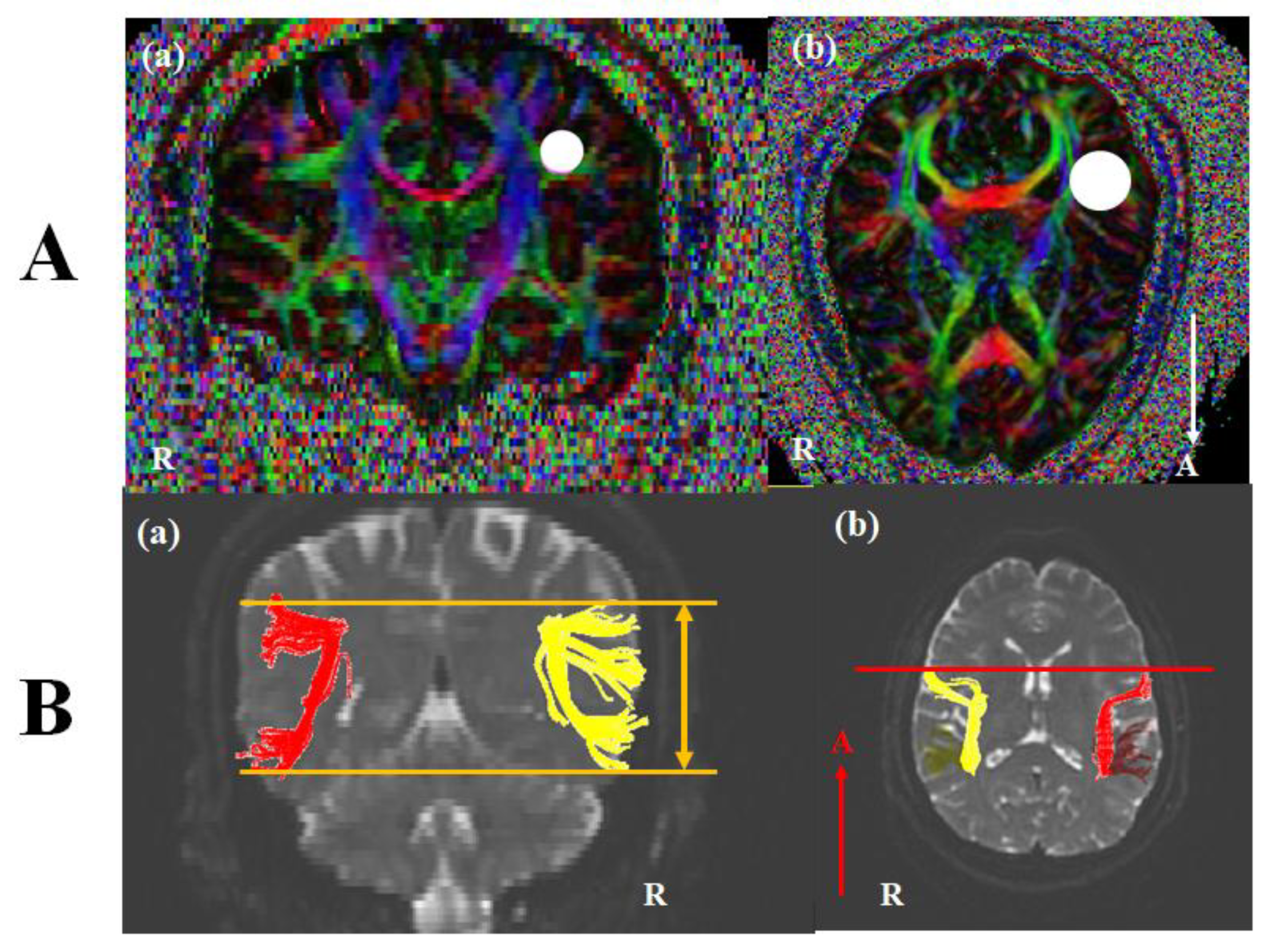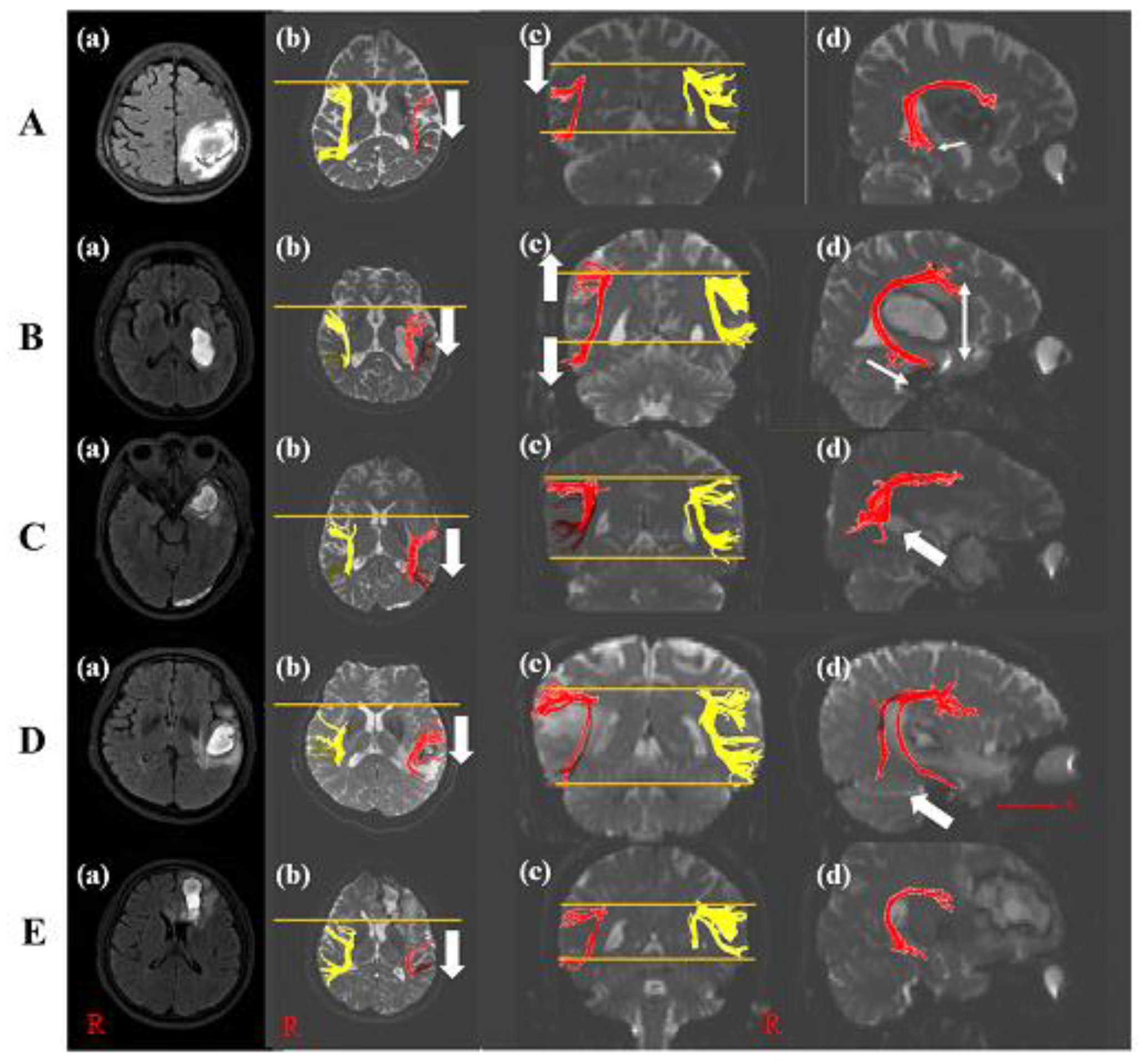Structural Characteristic of the Arcuate Fasciculus in Patients with Fluent Aphasia Following Intracranial Hemorrhage: A Diffusion Tensor Tractography Study
Abstract
1. Introduction
2. Materials and Methods
2.1. Subjects
2.2. Language Evaluation
2.3. Diffusion Tensor Image
3. Results
4. Discussion
5. Conclusions
Author Contributions
Funding
Conflicts of Interest
References
- Glasser, M.F.; Rilling, J.K. DTI tractography of the human brain’s language pathways. Cereb. Cortex 2008, 18, 2471–2482. [Google Scholar] [CrossRef] [PubMed]
- López-Barroso, D.; De Diego-Balaguer, R. Language learning variability within the dorsal and ventral streams as a cue for compensatory mechanisms in aphasia recovery. Front. Hum. Neurosci. 2017, 11, 1–7. [Google Scholar] [CrossRef] [PubMed]
- Tak, H.J.; Jang, S.H. Relation between aphasia and arcuate fasciculus in chronic stroke patients. BMC Neurol. 2014, 14, 1–5. [Google Scholar] [CrossRef] [PubMed]
- Kang, E.K.; Sohn, H.M.; Han, M.K.; Kim, W.; Han, T.R.; Paik, N.J. Severity of post-stroke aphasia according to aphasia type and lesion location in Koreans. J. Korean Med. Sci. 2010, 25, 123–127. [Google Scholar] [CrossRef]
- Hayashi, Y.; Kinoshita, M.; Nakada, M.; Hamada, J.I. Correlation between language function and the left arcuate fasciculus detected by diffusion tensor imaging tractography after brain tumor surgery. J. Neurosurg. 2012, 117, 839–843. [Google Scholar] [CrossRef]
- Jang, S.H.; Lee, A.Y.; Shin, S.M. Injury of the arcuate fasciculus in the dominant hemisphere in patients with mild traumatic brain injury: A retrospective cross-sectional study. Medicine (United States) 2016, 95, 1–5. [Google Scholar] [CrossRef]
- Ivanova, M.V.; Isaev, D.Y.; Dragoy, O.V.; Akinina, Y.S.; Petrushevskiy, A.G.; Fedina, O.N.; Shklovsky, V.M.; Dronkers, N.F. Diffusion-tensor imaging of major white matter tracts and their role in language processing in aphasia. Cortex 2016, 85, 165–181. [Google Scholar] [CrossRef]
- Kim, S.H.; Jang, S.H. Prediction of aphasia outcome using diffusion tensor tractography for arcuate fasciculus in stroke. Am. J. Neuroradiol. 2013, 34, 785–790. [Google Scholar] [CrossRef]
- Pedersen, P.M.; Vinter, K.; Olsen, T.S. Aphasia after stroke: Type, severity and prognosis: The Copenhagen aphasia study. Cerebrovasc. Dis. 2004, 17, 35–43. [Google Scholar] [CrossRef]
- Mavïş, İ. Language characteristics of fluent aphasic patients in Turkish. J. Multiling. Commun. Disord. 2005, 3, 75–89. [Google Scholar] [CrossRef]
- Jang, S.H. Diffusion tensor imaging studies on arcuate fasciculus in stroke patients: A review. Front. Hum. Neurosci. 2013, 7, 1–7. [Google Scholar] [CrossRef]
- Fridriksson, J.; Guo, D.; Fillmore, P.; Holland, A.; Rorden, C. Damage to the anterior arcuate fasciculus predicts non-fluent speech production in aphasia. Brain 2013, 136, 3451–3460. [Google Scholar] [CrossRef]
- Bernal, B.; Ardila, A. The role of the arcuate fasciculus in conduction aphasia. Brain 2009, 132, 2309–2316. [Google Scholar] [CrossRef]
- Clark, H.M.; Utianski, R.L.; Duffy, J.R.; Strand, E.A.; Botha, H.; Josephs, K.A.; Whitwell, J.L. Western Aphasia Battery-Revised Profiles in Primary Progressive Aphasia and Primary Progressive Apraxia of Speech. Am. J. Speezch-Lang. Pathol. 2020, 29, 498–510. [Google Scholar] [CrossRef] [PubMed]
- Jang, S.H.; Lee, J.; Yeo, S.S. Central post-stroke pain due to injury of the spinothalamic tract in patients with cerebral infarction: A diffusion tensor tractography imaging study. Neural. Regen. Res. 2017, 12, 2021–2024. [Google Scholar] [PubMed]
- Park, C.H.; Ryu, H.; Kim, C.H.; Joa, K.L.; Kim, M.O.; Jung, H.Y. Injury of Corticospinal Tract in a Patient with Subarachnoid Hemorrhage as Determined by Diffusion Tensor Tractography: A Case Report. Brain Sci. 2020, 10, 177. [Google Scholar] [CrossRef]
- Park, C.H.; Kim, S.H.; Jung, H.Y. Characteristics of the uncinate fasciculus and cingulum in patients with mild cognitive impairment: Diffusion tensor tractography study. Brain Sci. 2019, 9, 377. [Google Scholar] [CrossRef] [PubMed]
- Park, C.H.; Kim, S.H.; Jung, H.Y. Diffusion-Tensor-Tractography-Based Diagnosis for Injury of Corticospinal Tract in a Patient with Hemiplegia Following Traumatic Brain Injury. Diagnostics 2020, 10, 156. [Google Scholar] [CrossRef]
- Galantucci, S.; Tartaglia, M.C.; Wilson, S.M.; Henry, M.L.; Filippi, M.; Agosta, F.; Dronkers, N.F.; Henry, R.G.; Ogar, J.M.; Miller, B.L.; et al. White matter damage in primary progressive aphasias: A diffusion tensor tractography study. Brain 2011, 134, 3011–3029. [Google Scholar] [CrossRef]
- Yoo, J.S.; Choi, B.Y.; Chang, C.H.; Jung, Y.J.; Kim, S.H.; Jang, S.H. Characteristics of injury of the corticospinal tract and corticoreticular pathway in hemiparetic patients with putaminal hemorrhage. BMC Neurol. 2014, 14, 15–18. [Google Scholar] [CrossRef]
- Kim, H.; Na, D.L. Normative data on the Korean version of the Western Aphasia Battery. J. Clin. Exp. Neuropsychol. 2004, 26, 1011–1020. [Google Scholar] [CrossRef]
- Kang, E.K.; Sohn, H.M.; Han, M.K.; Paik, N.J. Subcortical aphasia after stroke. Ann. Rehabil. Med. 2017, 41, 725–733. [Google Scholar] [CrossRef] [PubMed]
- Jang, S.H.; Seo, Y.S. Diagnosis of Conversion Disorder Using Diffusion Tensor Tractography and Transcranial Magnetic Stimulation in a Patient with Mild Traumatic Brain Injury. Diagnostics 2019, 9, 155. [Google Scholar] [CrossRef] [PubMed]
- Jang, S.H.; Seo, J.P. Differences of the medial lemniscus and spinothalamic tract according to the cortical termination areas: A diffusion tensor tractography study. Somatosens. Mot. Res. 2015, 32, 67–71. [Google Scholar] [CrossRef] [PubMed]
- Santillo, A.F.; Mårtensson, J.; Lindberg, O.; Nilsson, M.; Manzouri, A.; Landqvist Waldö, M.; van Westen, D.; Wahlund, L.O.; Lätt, J.; Nilsson, C. Diffusion Tensor Tractography versus Volumetric Imaging in the Diagnosis of Behavioral Variant Frontotemporal Dementia. PLoS ONE 2013, 8, e66932. [Google Scholar] [CrossRef] [PubMed]
- Jang, S.H.; Yi, J.H.; Kwon, H.G. Injury of the inferior cerebellar peduncle in patients with mild traumatic brain injury: A diffusion tensor tractography study. Brain Inj. 2016, 30, 1271–1275. [Google Scholar] [CrossRef]
- Jang, S.H.; Seo, Y.S. Diagnosis of complex regional pain syndrome I following traumatic axonal injury of the corticospinal tract in a patient with mild traumatic brain injury. Diagnostics 2020, 10, 95. [Google Scholar] [CrossRef]
- Binder, J.R. The Wernicke area: Modern evidence and a reinterpretation. Neurology 2015, 85, 2170–2175. [Google Scholar] [CrossRef]
- Radanovic, M.; Mansur, L.L. Aphasia in vascular lesions of the basal ganglia: A comprehensive review. Brain Lang. 2017, 173, 20–32. [Google Scholar] [CrossRef]
- Budd, M.A.; Kortte, K.; Cloutman, L.; Newhart, M.; Gottesman, R.F.; Davis, C.; Heidler-Gary, J.; Seay, M.W.; Hillis, A.E. The Nature of Naming Errors in Primary Progressive Aphasia Versus Acute Post-Stroke Aphasia. Neuropsychology 2010, 24, 581–589. [Google Scholar] [CrossRef]
- Foundas, A.L.; Daniels, S.K.; Vasterling, J.J. Anomia: Case studies with lesion localization. Neurocase 1998, 4, 35–43. [Google Scholar] [CrossRef]
- Henseler, I.; Regenbrecht, F.; Obrig, H. Lesion correlates of patholinguistic profiles in chronic aphasia: Comparisons of syndrome-, modality-and symptom-level assessment. Brain 2014, 137, 918–930. [Google Scholar] [CrossRef] [PubMed]
- Keser, Z.; Sebastian, R.; Hasan, K.M.; Hillis, A.E. Right Hemispheric Homologous Language Pathways Negatively Predicts Poststroke Naming Recovery. Stroke 2020, 51, 1002–1005. [Google Scholar] [CrossRef] [PubMed]
- Vernooij, M.W.; Smits, M.; Wielopolski, P.A.; Houston, G.C.; Krestin, G.P.; van der Lugt, A. Fiber density asymmetry of the arcuate fasciculus in relation to functional hemispheric language lateralization in both right- and left-handed healthy subjects: A combined fMRI and DTI study. Neuroimage 2007, 35, 1064–1076. [Google Scholar] [CrossRef]
- Nucifora, P.G.P.; Verma, R.; Melhem, E.R.; Gur, R.E.; Gur, R.C. Leftward asymmetry in relative fiber density of the arcuate fasciculus. Neuroreport 2005, 16, 791–794. [Google Scholar] [CrossRef]
- Wilkinson, M.; Lim, A.R.; Cohen, A.H.; Galaburda, A.M.; Takahashi, E. Detection and growth pattern of arcuate fasciculus from newborn to adult. Front. Neurosci. 2017, 11, 1–15. [Google Scholar] [CrossRef] [PubMed]
- Takaya, S.; Kuperberg, G.R.; Liu, H.; Greve, D.N.; Makris, N.; Stufflebeam, S.M. Asymmetric projections of the arcuate fasciculus to the temporal cortex underlie lateralized language function in the human brain. Front. Neuroanat. 2015, 9, 1–12. [Google Scholar] [CrossRef][Green Version]
- Forkel, S.J.; De Schotten, M.T.; Dell’Acqua, F.; Kalra, L.; Murphy, D.G.M.; Williams, S.C.R.; Catani, M. Anatomical predictors of aphasia recovery: A tractography study of bilateral perisylvian language networks. Brain 2014, 137, 2027–2039. [Google Scholar] [CrossRef]


| K-WAB | ||||||||||
|---|---|---|---|---|---|---|---|---|---|---|
| Patient | Sex/Age (Years) | Duration to DTI (Days) | Lesion Site | AQ (%ile) | LQ (%ile) | Spontaneous/20 (Fluency/10) | Comprehension/200 | Repetition/100 | Naming/100 | Type |
| 1 | F/60 | 21 days | Left parietal lobe | 27.5 (20.1) | 22.3 (20.8) | 9 (6) | 75 | 4 | 6 | Wernicke |
| 2 | M/47 | 28 days | Left basal ganglia | 31.8 (23.2) | 23.4 (21.7) | 11 (7) | 34 | 6 | 26 | Wernicke |
| 3 | M/50 | 25 days | Left temporal lobe | 62.1 (51.0) | 57.6 (58.3) | 13 (6) | 129 | 73 | 43 | Transcortical sensory |
| 4 | F/60 | 21 days | Left temporal lobe | 69.5 (73.6) | 67.9 (81.8) | 15 (8) | 140 | 59 | 70 | Conduction |
| 5 | M/58 | 28 days | Left frontal lobe | 70.6 (75.1) | 65.7 (79.6) | 12 (6) | 143.5 | 90 | 71 | Anomic |
| Left AF | Right AF | |||||||
|---|---|---|---|---|---|---|---|---|
| Patient | FA | TV | MD (×10−3 mm2/s) | FN | FA | TV | MD(×10−3 mm2/s) | FN |
| 1 | 0.4912 ** | 986 ** | 0.7948 | 184 ** | 0.5285 | 3102 | 0.7013 | 479 |
| 2 | 0.4915 ** | 1975 | 0.7496 | 289 ** | 0.5526 | 2530 | 0.6962 | 580 |
| 3 | 0.4909 ** | 2435 | 0.7503 | 468 | 0.5233 | 2218 | 0.7369 | 444 |
| 4 | 0.4135 ** | 1912 ** | 0.8345 ** | 355 | 0.479 | 3240 | 0.7551 | 594 |
| 5 | 0.5162 | 831 ** | 0.7844 | 95 ** | 0.4754 | 2115 | 0.7705 | 384 |
| Controls | 0.5252 (0.015) | 2551.625 (272.461) | 0.7513 (0.026) | 545.125 (89.606) | 0.5200 (0.034) | 2690.063 (429.588) | 0.7233 (0.028) | 524.750 (81.271) |
© 2020 by the authors. Licensee MDPI, Basel, Switzerland. This article is an open access article distributed under the terms and conditions of the Creative Commons Attribution (CC BY) license (http://creativecommons.org/licenses/by/4.0/).
Share and Cite
Ryu, H.; Park, C.-H. Structural Characteristic of the Arcuate Fasciculus in Patients with Fluent Aphasia Following Intracranial Hemorrhage: A Diffusion Tensor Tractography Study. Brain Sci. 2020, 10, 280. https://doi.org/10.3390/brainsci10050280
Ryu H, Park C-H. Structural Characteristic of the Arcuate Fasciculus in Patients with Fluent Aphasia Following Intracranial Hemorrhage: A Diffusion Tensor Tractography Study. Brain Sciences. 2020; 10(5):280. https://doi.org/10.3390/brainsci10050280
Chicago/Turabian StyleRyu, Hyeong, and Chan-Hyuk Park. 2020. "Structural Characteristic of the Arcuate Fasciculus in Patients with Fluent Aphasia Following Intracranial Hemorrhage: A Diffusion Tensor Tractography Study" Brain Sciences 10, no. 5: 280. https://doi.org/10.3390/brainsci10050280
APA StyleRyu, H., & Park, C.-H. (2020). Structural Characteristic of the Arcuate Fasciculus in Patients with Fluent Aphasia Following Intracranial Hemorrhage: A Diffusion Tensor Tractography Study. Brain Sciences, 10(5), 280. https://doi.org/10.3390/brainsci10050280





